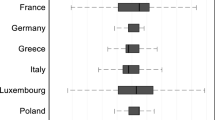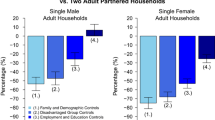Abstract
Using individual bank account data from South Korea, where joint accounts are rare and the legal system emphasizes the individuality of financial transactions, we examine the distribution of financial resources between spouses within households. We find that each member’s share of household savings depends on the balance of bargaining power. We also find that the wife’s bargaining power increases total household savings. The findings deviate from the unitary model.
Similar content being viewed by others
References
Anderson, S., & Baland, J.-M. (2002). The economics of Roscas and intrahousehold resource allocation. Quarterly Journal of Economics, August 2002, 963–995.
Barber, B., & Odean, T. (2001). Boys will be boys: Gender, overconfidence, and common stock investment. Quarterly Journal of Economics, 116(1), 261–292.
Basu, K. (2006). Gender and say: A model of household behavior with endogenously-determined balance of power. Economic Journal, 116, 558–580.
Bourguignon, F., Browning, M., Chiappori, P-A., & Lechene, V. (1993). Intra-household allocation of consumption: a model and some evidence from French data. Annals d’Economie et de Statistique, 29, 138–156.
Browning, M. (2000). The saving behavior of a two-person household. Scandinavian Journal of Economics, 102(2), 235–251.
Browning, M., & Lusardi, A. (1996). Household saving: Micro theories and micro facts. Journal of Economic Literature, 34, 1797–1855.
Browning, M., & Chiappori, P.-A. (1998). Efficient intra-household allocations: A general characterization and empirical tests. Econometrica, 66(6), 1241–1278.
Browning, M., Chiappori, P.-A., & Lechene, V. (2006). Collective and unitary models: A clarification. Review of Economics of the Household, 4, 5–14.
Browning, M., Bourguignon, F., Chiappori, P.-A., & Lechene, V. (1994). Income and outcomes: A structural model of intrahousehold allocation. Journal of Political Economy, 102(6), 1067–1096.
Cho, E., & Chun, K. (2004). A study on marriage property system reform in Korea. Working Paper, 210-20, Korean Women’s Development Institute (in Korean).
Dobbelsteen, S., & Kooreman, P. (1997) Financial management, bargaining and efficiency within the household: An empirical analysis. De Economist, 145, 345–366.
Grossbard-Shechtman, A. (1984). A theory of allocation of time in markets for labour and marriage. Economic Journal, 94(4), 863–882.
Hoddinott, J., & Haddad, L. (1995). Does female income share influence household expenditures? Evidnece from Côte D’Ivoire. Oxford Bulletin of Economics and Statistics, 57(1), 77–96.
Jianakoplos, N., & Bernasek, A. (1998). Are women more risk averse. Economic Inquiry, 36(4), 620–630.
Johnson, W. R., & Skinner, J. (1986). Labor supply and marital separation. American Economic Review, 76(3), 455–469.
Lee, H. (1990). Implications and problems of property division claim right under new family law. Women’s Study, Korean Women’s Development Institute, Spring 1990, 26 (in Korean).
Lich-Tyler, S. (2003). The consumption dynamics and savings behavior of pluralistic households. mimeo, Department of Economics, University of Michigan, April 2003
Lundberg, S., & Pollak, R. A. (1996). Bargaining and distribution in marriage. Journal of Economic Perspective, 10(4), 139–158.
Lundberg, S., & Ward-Batts, J. (2000). Saving for retirement: household bargaining and household net worth. mimeo, Department of Economics, University of Washington, January
Mazzocco, M. (2004). Saving, risk sharing, and preferences for risk. American Economic Review, 94(4), 1169–1182.
Nargis, N. (2003). The life-cycle saving behavior of two-person households: Evidence from the U.S. panel study of income dynamics. mimeo, Department of Economics, Cornell University, January
Pahl, J. (1980). Patterns of money management within marriage. Journal of Social Policy, 9, 313–315.
Pahl, J. (1989). Money and marriage. New York: St. Martin’s Press.
Phipps, S., & Burton, P. (1992). What’s mine is yours? The influence of male and female incomes on patterns of household expenditure. Working Paper 92-12, Department of Economics, Dalhousie University
Pitt, M. M., Khandker, S. R., & Cartwright, J. (2003). Does micro-credit empower women? Evidence from Bangladesh. Policy Research Working Paper, No. 2998, World Bank
Pollak, R. A. (2005). Bargaining power in marriage: Earnings, wage rates and household production. mimeo, January 2005.
Seoul Women’s Foundation (2006). Yearbook of Seoul women’s statistics.
Thomas, D. (1990). Intra-household resource allocation: An inferential approach. Journal of Human Resources, 25(4), 653–664.
Treas, J. (1993). Money in the bank: Transaction costs and the economic organization of marriage. American Sociological Review, 58, 723–734.
Won, Y.-S. (1992). A study on the problems of matrimonial property system and their solution in Korean family law. Asian Women’s Study, 31 (in Korean).
Woolley, F. (2003). Control over money in marriage. In S. A. Grossbard-Shechtman (Ed.), Marriage and the economy: Theory and evidence from advanced industrial societies, Cambridge University Press.
Zelizer, V. A. (1989). The social meaning of money: Special monies. Americal Journal of Sociology, 95, 342–377.
Acknowledgments
We are thankful of the editor and an anonymous referee for their constructive comments. We also like to thank David Allen, Li Gan, Daniel Hamermesh, Steve Trejo, and seminar participants at the 2003 annual conference of Southern Economic Association and the Center for East Asian Studies, the University of Texas at Austin. Lee acknowledges the grant from the Bank of America Research Fund honoring James H. Penick. Pocock acknowledges funding from the Ward Fellowship. The views expressed in this paper do not necessarily reflect those of the Office of the Comptroller of the Currency.
Author information
Authors and Affiliations
Corresponding author
Rights and permissions
About this article
Cite this article
Lee, J., Pocock, M. Intrahousehold allocation of financial resources: evidence from South Korean individual bank accounts. Rev Econ Household 5, 41–58 (2007). https://doi.org/10.1007/s11150-007-9004-3
Received:
Accepted:
Published:
Issue Date:
DOI: https://doi.org/10.1007/s11150-007-9004-3




